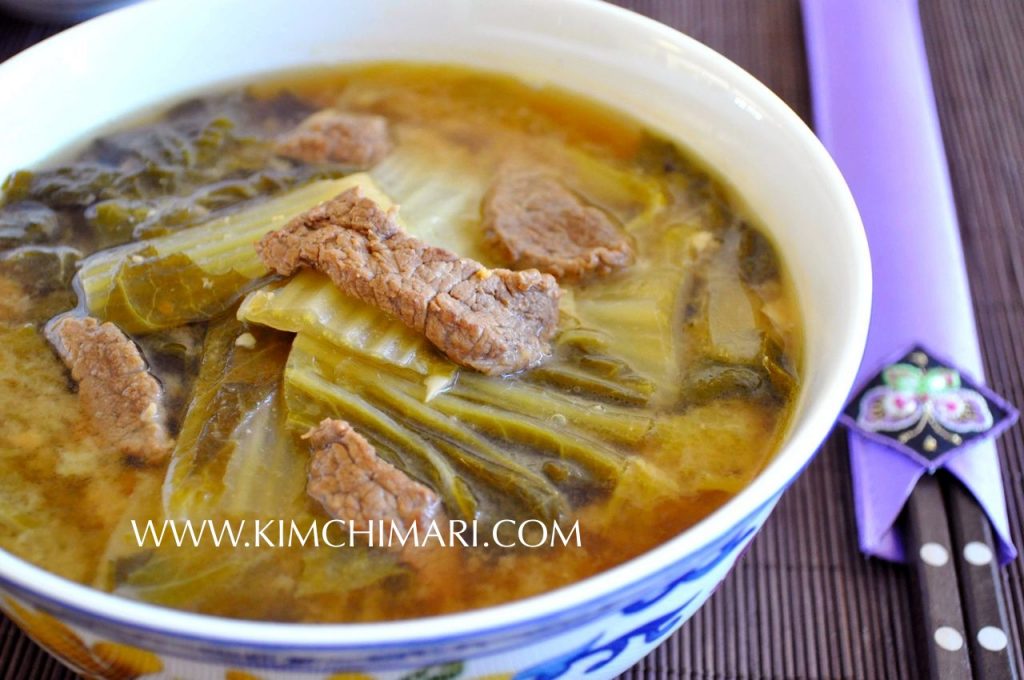
Baechu Doenjang Guk made with Korean fermented soybean paste (pronounced ‘dwenjang’) is the ultimate comfort food for Koreans. A bowl of this cabbage soup, some rice and kimchi will make any Korean’s mouth water and take them back home when they taste it. I know the phrase “comfort foods” has come to be known as foods that bring you back to your childhood days, but”comfort foods” are also known to be mostly unhealthy – high in fat, sugar or carbs. However, this soup is quite healthy. The health benefits of soybean paste are well known to provide various vitamins, minerals, flavonoids and even anticarcinogenic effects even after it is boiled in the soup. Baechu (napa cabbage) is high in vitamin K, vitamin C and dietary fiber (which is very good for your GI and constipation) . It is also known to contain phytochemicals (called indoles) “which are being studied for their ability to convert estradiol, an estrogen like hormone that may play a role in the development of breast cancer, into a safer form of estrogen” according to an article in How Stuff works.
In addition to these studies and analyses, what I know firsthand about baechu-especially put-baechu 풋배추 or Korean small cabbage “green seoul” is that it has great healing properties when it comes to GI issues. My mother-in-law told me (um..I don’t know.. maybe about 10 times? 😉 ) that whenever my husband had really bad stomach problems with terrible diarrhea (he basically had IBS when he was a college student), she made juice out of raw put-baechus and made him drink it in the morning. Pretty nasty stuff according to my hubby but it cured him every time!
Prep time: 10 min Cooking time: 20 – 25 min Servings: 6 Difficulty: Easy
Ingredients
- 2 heads of Korean small cabbage or 1 medium size napa cabbage
- 10 oz beef stew meat (chuck roast)
- 1 T vegetable oil for frying meat if beef is very lean
- 11 C water or anchovy stock or rice water
- 5-6 T Korean soybean paste (Doenjang)
- 1 T Miso
- 3 T chopped garlic
- 1 tsp garlic powder
- 3 green onions
Directions
1. My favorite cabbage to use is the Korean small cabbage or green seoul, but I know these cabbages are not easy to come by. Napa cabbage works really well too. I know many traditional recipes will tell you to boil the cabbages first in water and then use the cooked cabbage in the soup. I cooked this way for years and one day discovered that the soup tastes fine (probably the cabbage is less chewy when pre-cooked) even if you don’t pre-cook the cabbage. Cooking the cabbage once instead of twice saves a lot of time and energy without losing much in flavor, so I’m all for it!
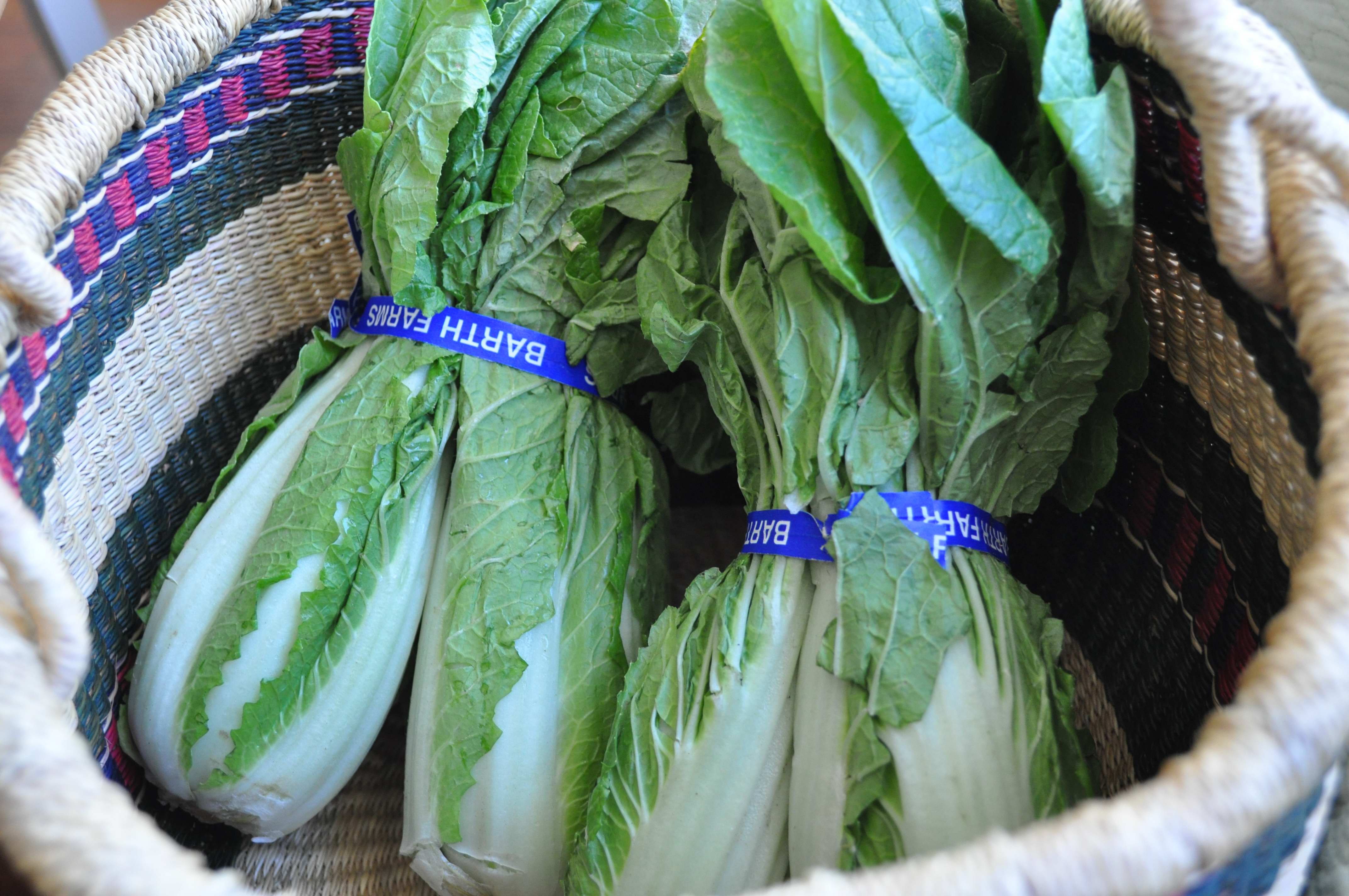
First, cut the heads off of the cabbages so it is easier to wash the leaves separately.
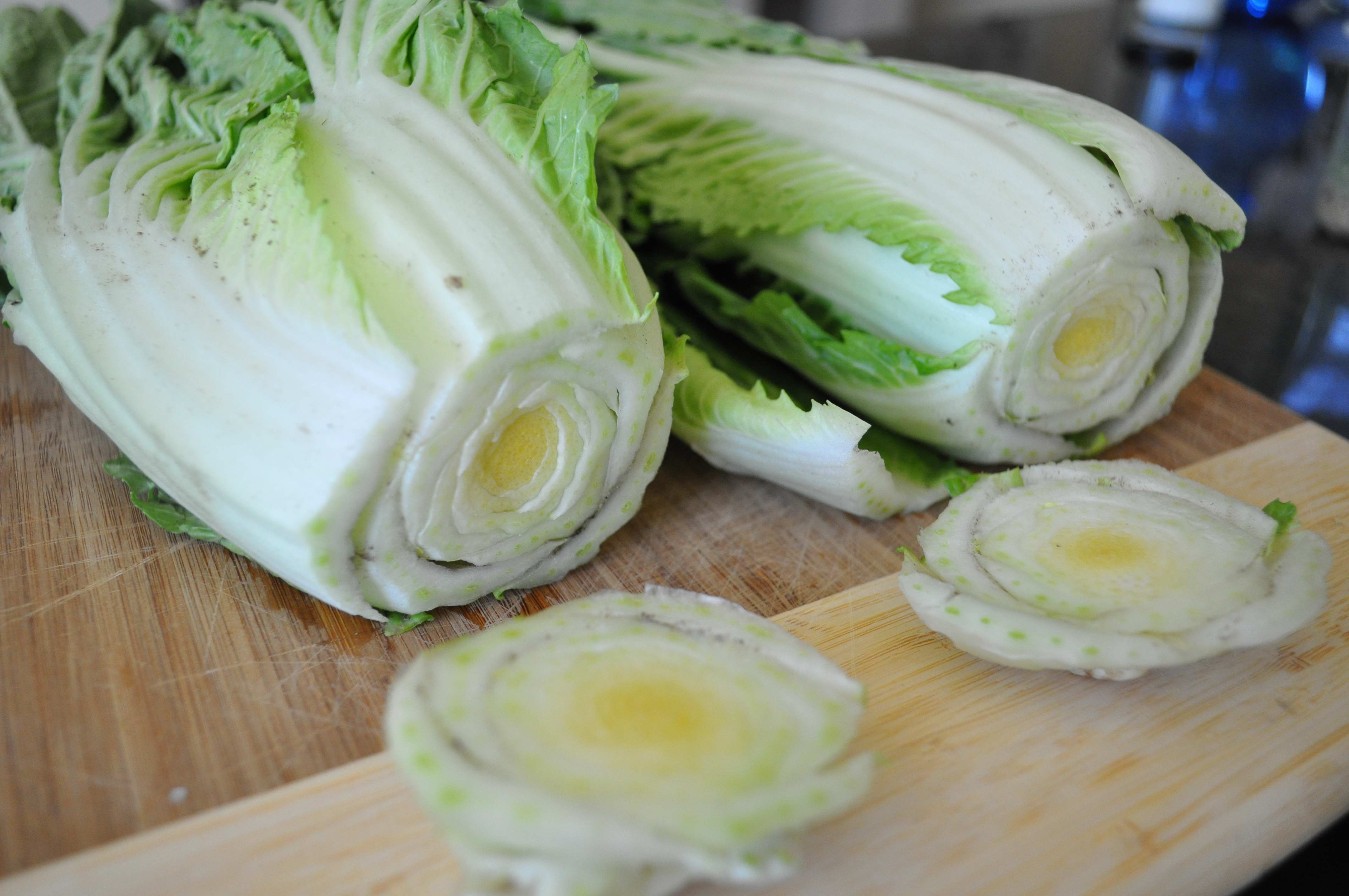
2. Cut away any damaged or diseased edges of the bigger leaves like so..

Cut the leaves into approx 3 in long pieces and set aside. How big you cut your cabbage is somewhat of a personal preference. Some Koreans like to cut them pretty short or thin. The size of the pieces really does not affect the taste but more varies the appearance and the texture. I like my pieces a bit long to give the soup a more heartier feel and texture.
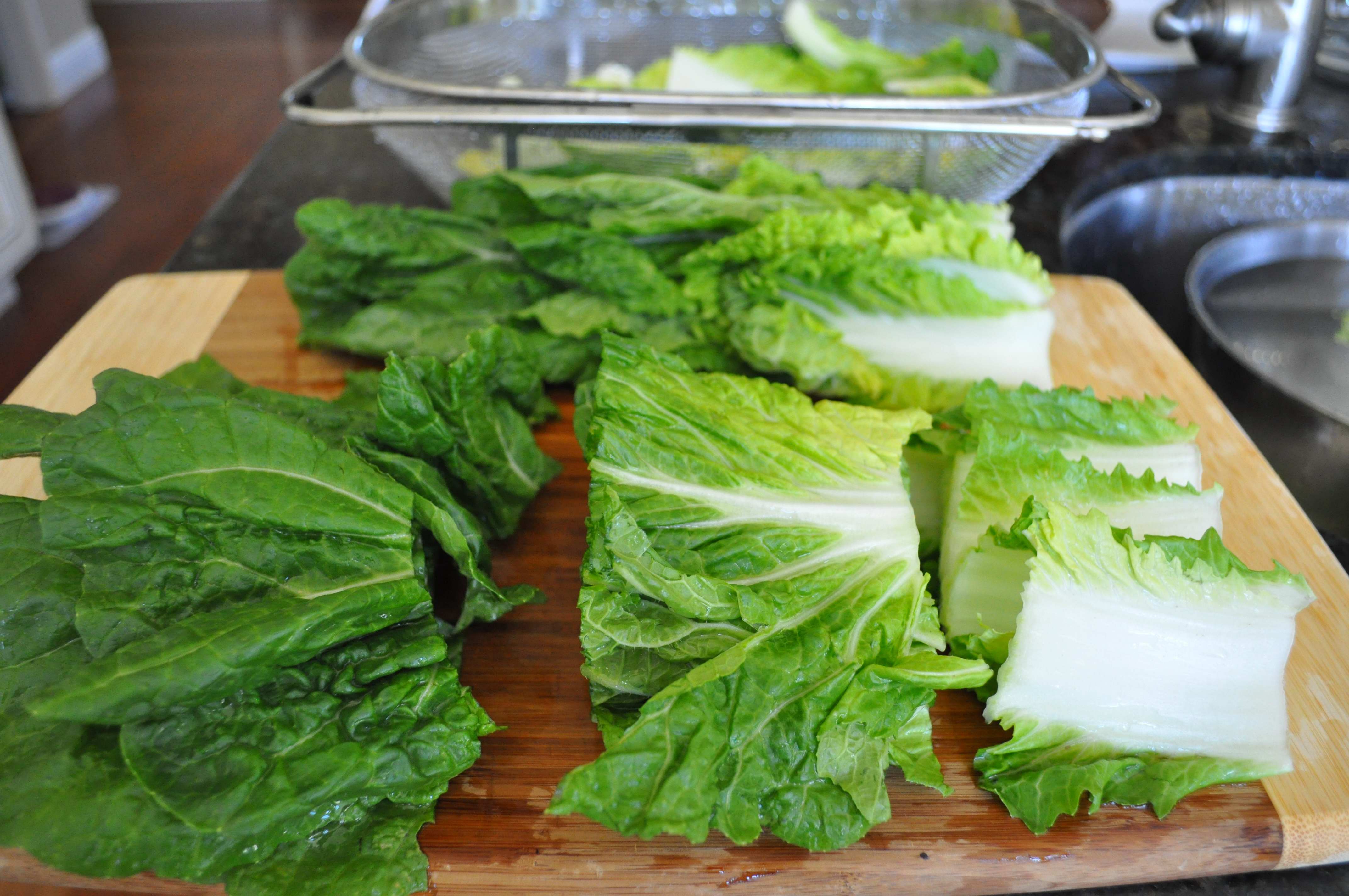
3. Cut the stew meat into smaller, thinner strips that can be easily eaten in one bite. When cutting the meat, try to cut against the grain. Because the pieces are so small and because they will be cooked thoroughly in the soup, it is not as important but cutting against the grain will ensure the meat will melt in the mouth along with the cabbage.
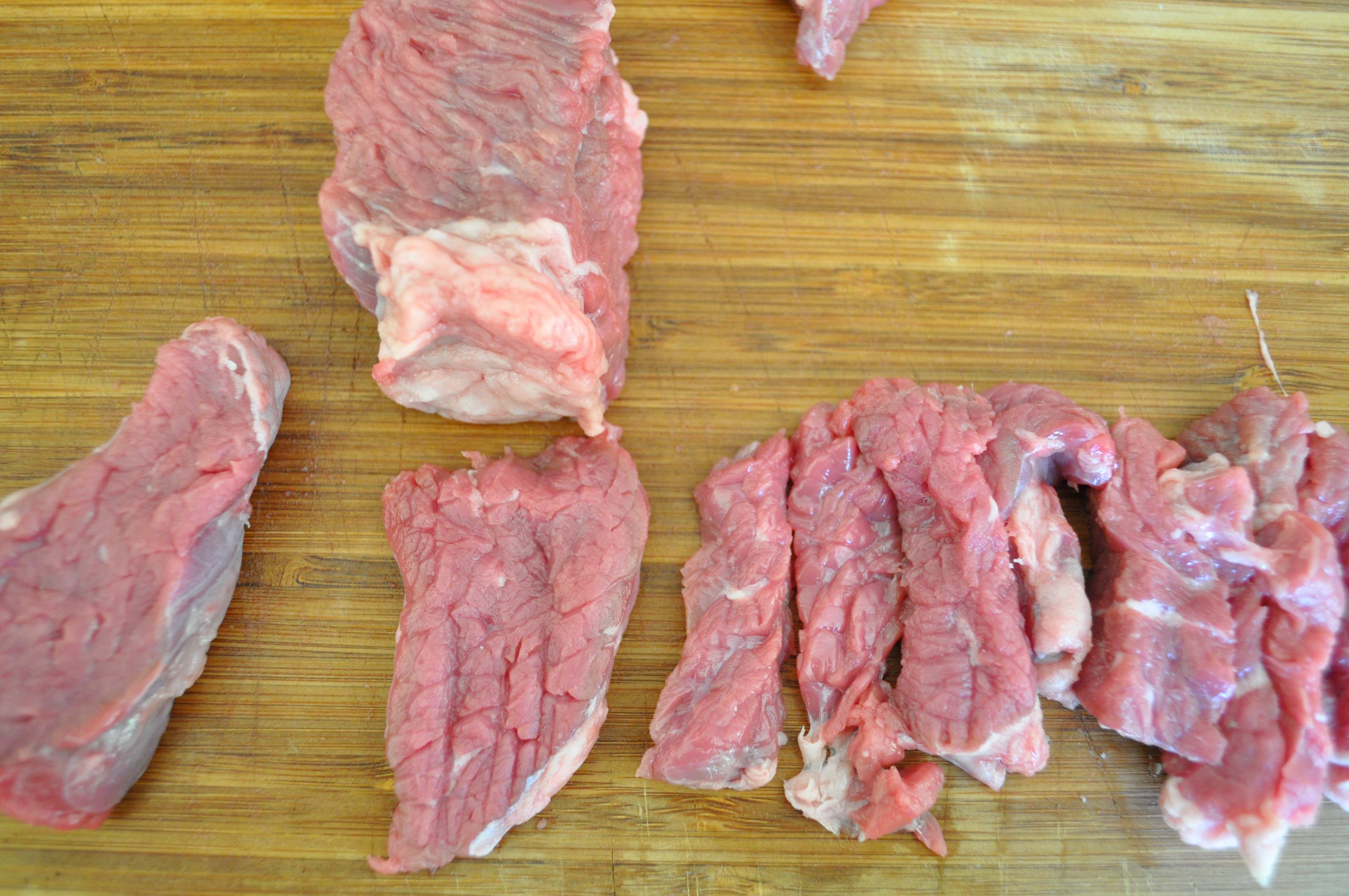
4. If the beef is very lean, add some oil to a large soup pot. Stir fry the beef and chopped garlic on medium high heat until the meat is slightly cooked.

5. Once the beef is slightly browned, add water or anchovy stock or rice water. Anchovy stock will additional depth of flavor to the dish. Rice water makes the soup a bit thicker. Rice water is the milky water you get from rinsing the rice before you cook.
6. Add 5 – 6 T of Korean soybean paste and 1 T of miso paste to the soup. Adding miso is really not traditional but I really like the touch of sweetness and smoothness it adds to the soup. So miso is optional but try it. When adding the soybean paste, kind of smoosh the paste on the side of the pot with a spoon and let it get dispersed into the soup. Start by adding just 5 T and miso, let it boil first and taste before adding more. You can always add more soybean paste later if you feel that it is not enough – even after adding the cabbage.
The soybean paste I use is made by Haechandle.
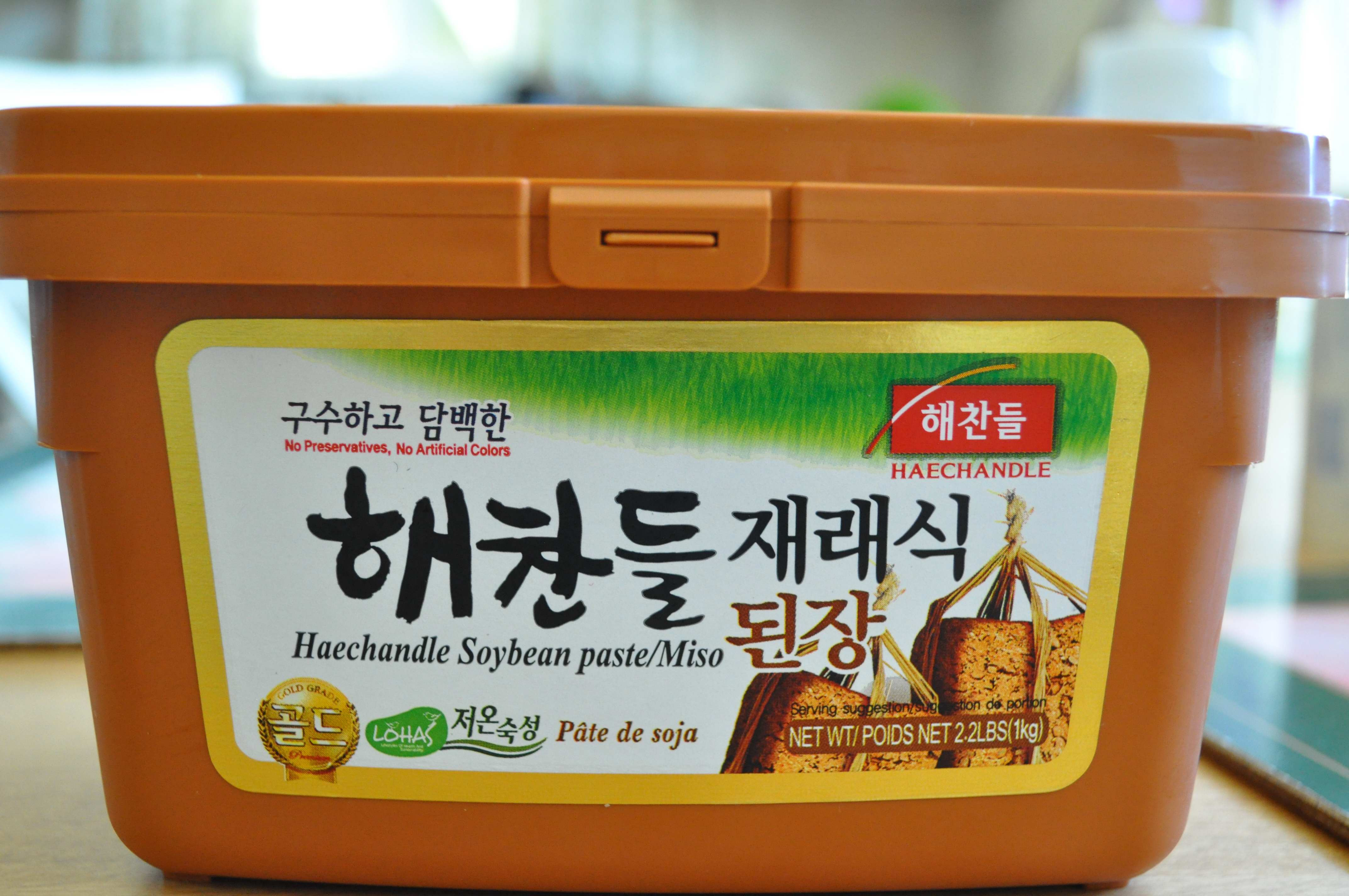
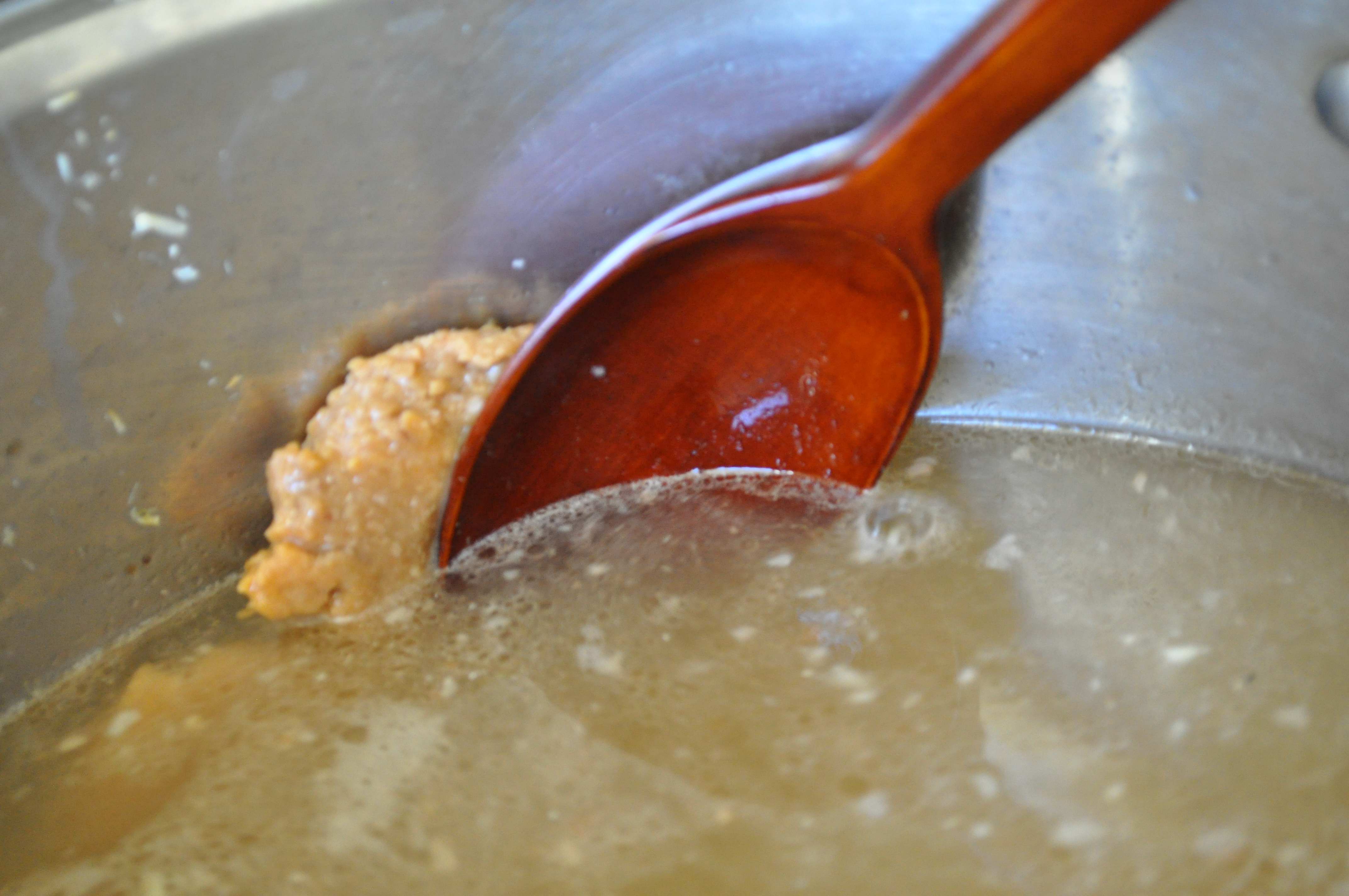
6. Bring the soybean paste soup to boil. Add the cut cabbage and bring to boil again. Reduce the heat to medium low and simmer for 20 minutes.
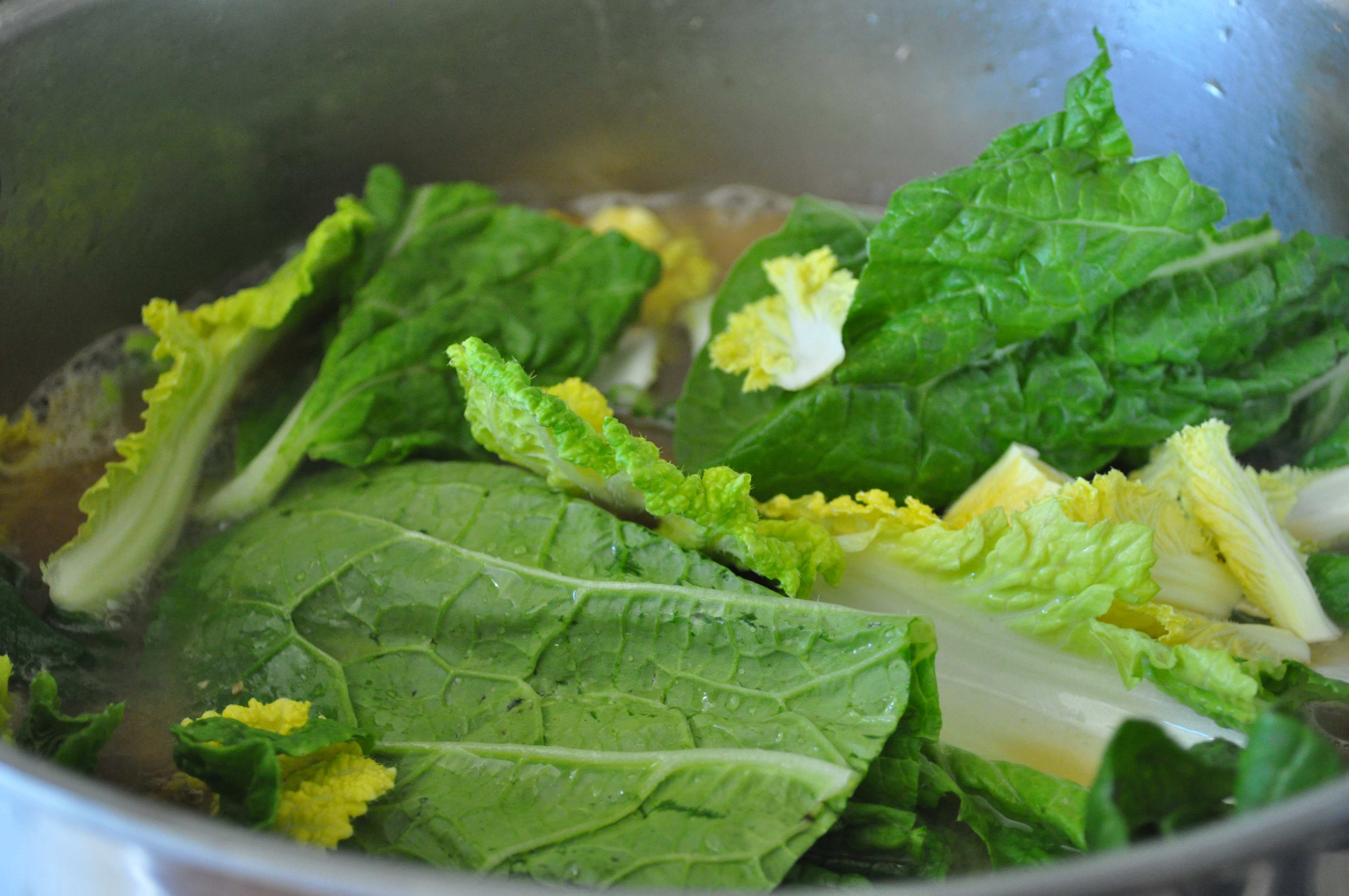
When you add the baechu to the soup, it may first seem like there’s too much baechu but the volume decreases a lot once they are cooked so don’t worry. When I first made this soup, I used to always have too much soup andnot have enough baechu and that’s not good..
7. After it has simmered for 20 minutes, add some cut up green onions, garlic powder and cook for another few minutes. The soup is now ready to eat. Serve with some rice and kimchi. Other banchans such as myulchi bokkeum and maleun saewoo bokkeum will go really well with this soup.
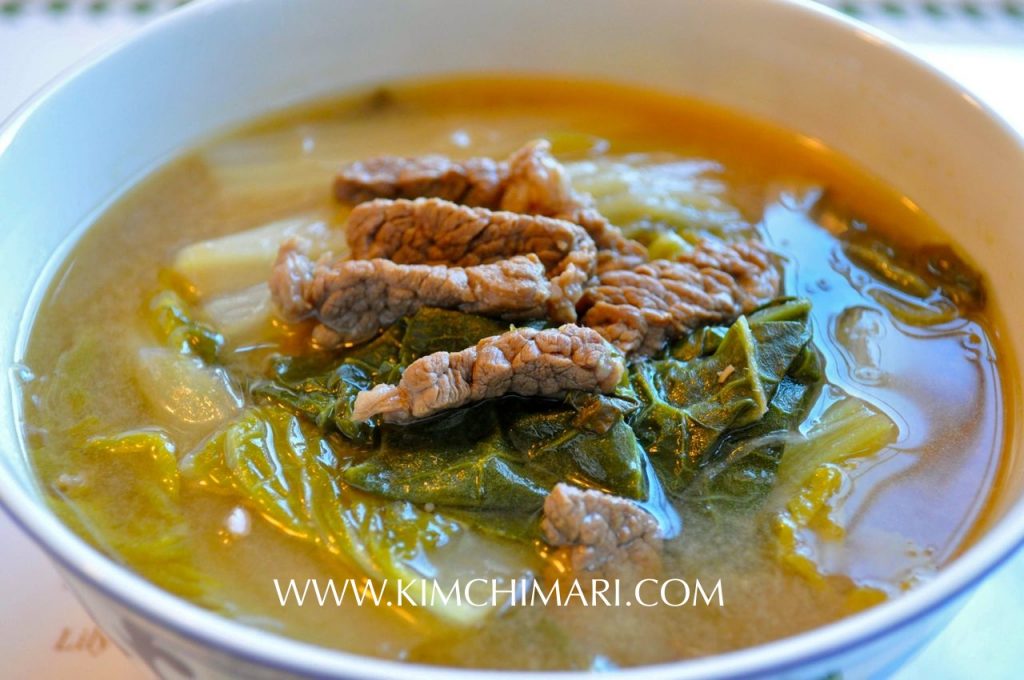
Cabbage Soybean Paste Soup (Baechu Doenjang Guk)
Ingredients
- 2 heads Korean small cabbage (or 1 medium size napa cabbage)
- 10 oz beef stew meat (chuck roast)
- 1 Tbs vegetable oil (for frying meat if beef is very lean)
- 11 cups water or anchovy stock or rice water
- 5 Tbs Korean soybean paste (Doenjang), add more to taste
- 1 Tbs miso
- 3 Tbs chopped garlic
- 1 tsp garlic powder
- 3 green onions
Instructions
- First, cut the heads off of the cabbages so it is easier to wash the leaves separately.
- Cut away any damaged or diseased edges of the bigger leaves.
- Cut the leaves into approx. 3 in long pieces and set aside. How big you cut your cabbage is somewhat of a personal preference. Some Koreans like to cut them pretty short or thin. The size of the pieces really does not affect the taste but more varies the appearance and the texture. I like my pieces a bit long to give the soup a more heartier feel and texture.
- Cut the stew meat into smaller, thinner strips that can be easily eaten in one bite. When cutting the meat, try to cut against the grain. Because the pieces are so small and because they will be cooked thoroughly in the soup, it is not as important but cutting against the grain will ensure the meat will melt in the mouth along with the cabbage.
- If the beef is very lean, add some oil to a large soup pot. Stir fry the beef and chopped garlic on medium high heat until the meat is slightly cooked.
- Once the beef is slightly browned, add water or anchovy stock or rice water.
- Add Korean soybean paste and miso paste to the soup. Adding miso is really not traditional but I really like the touch of sweetness and smoothness it adds to the soup. It takes a while for the soybean paste to fully disperse throughout the soup so let it boil first and taste before adding more.
- Bring the soybean paste soup to a boil. Add cabbage and bring to a boil again. Reduce heat to medium low and simmer for 20 minutes.
- After it has simmered for 20 minutes, add green onions, garlic powder and cook for another few minutes. Serve with some rice and kimchi. Other banchans such as myulchi bokkeum and maleun saewoo bokkeum will go really well with this soup.
Tips & Notes:
- My favorite cabbage to use is the Korean small cabbage or green seoul, but I know these cabbages are not easy to come by. Napa cabbage works really well too.
- I know many traditional recipes will tell you to boil the cabbages first in water and then use the cooked cabbage in the soup. I cooked this way for years and one day discovered that the soup tastes fine (probably the cabbage is less chewy when pre-cooked) even if you don’t pre-cook the cabbage. Cooking the cabbage once instead of twice saves a lot of time and energy without losing much in flavor, so I’m all for it!
Nutrition Information:
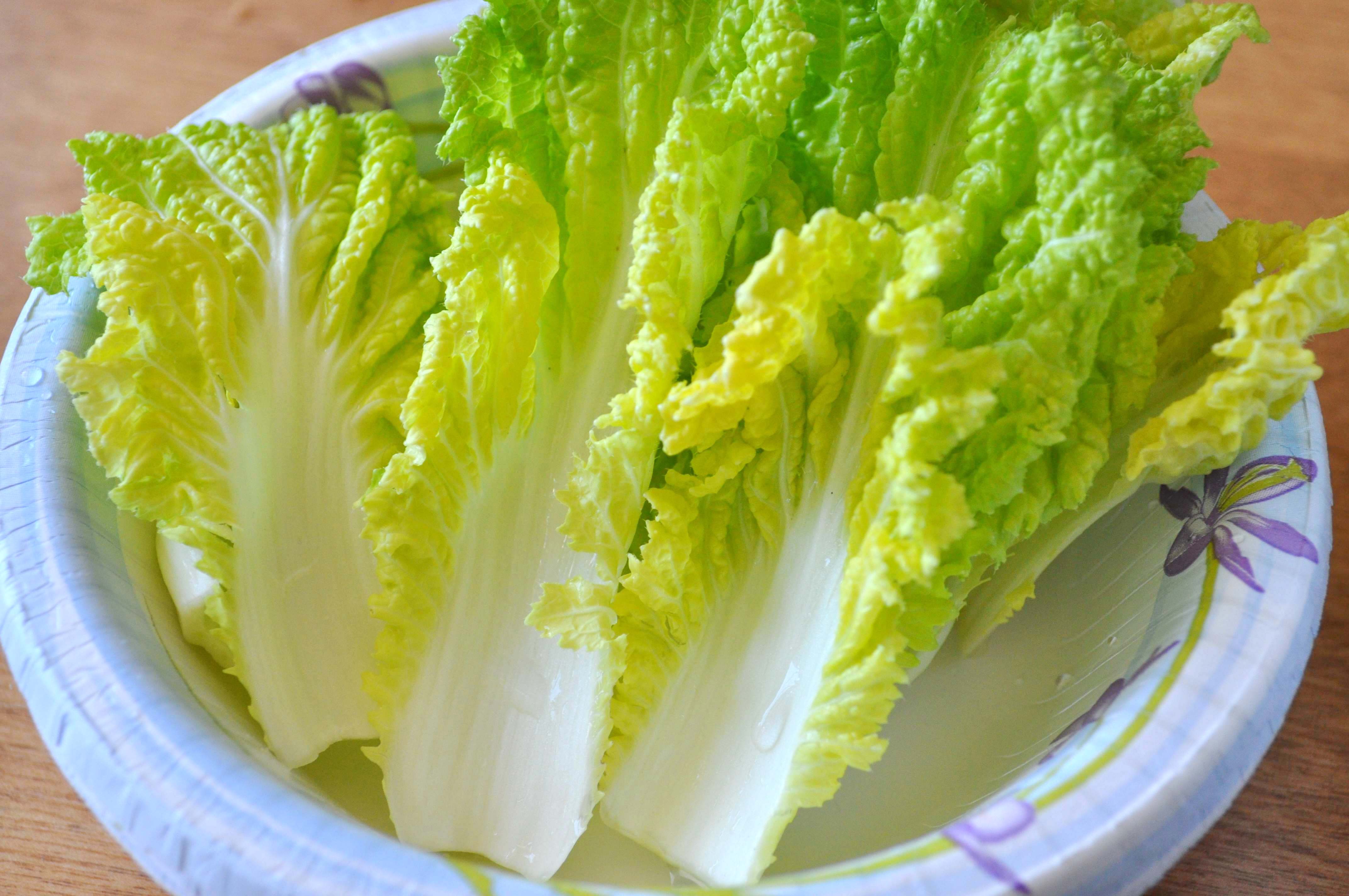
One of the extras of using a whole cabbage is the hearts of the Korean cabbage. You can save it and eat separately as ssam with some ssamjang. The heart of a cabbage has a much sweeter taste and has almost no bitterness. It tastes great with rice and some ssamjang.
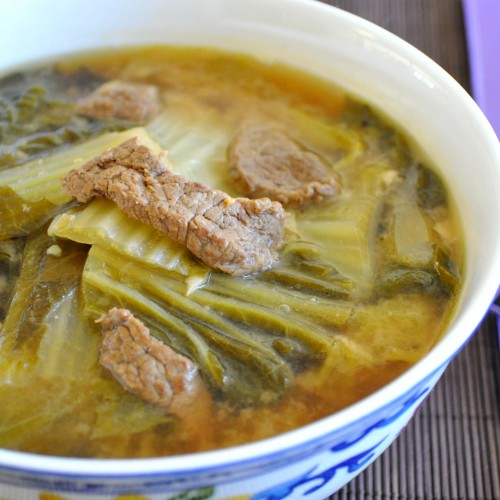
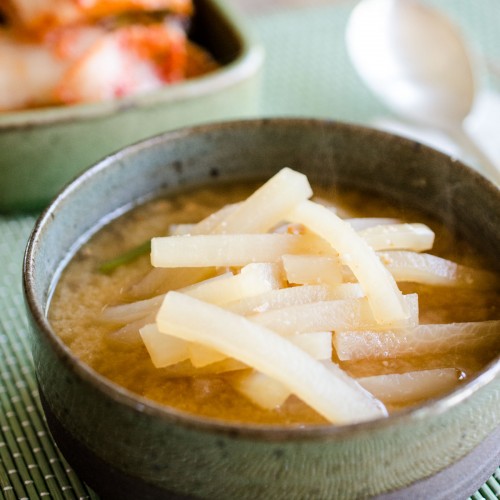
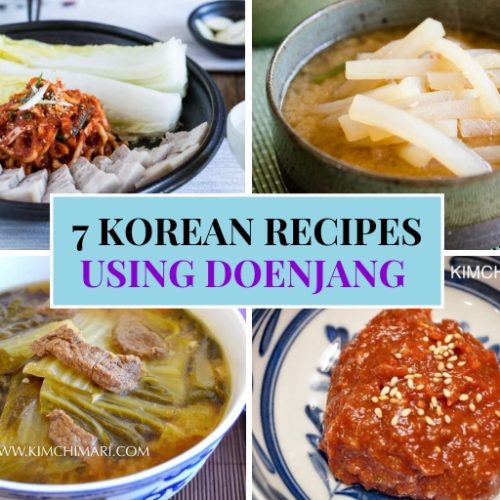

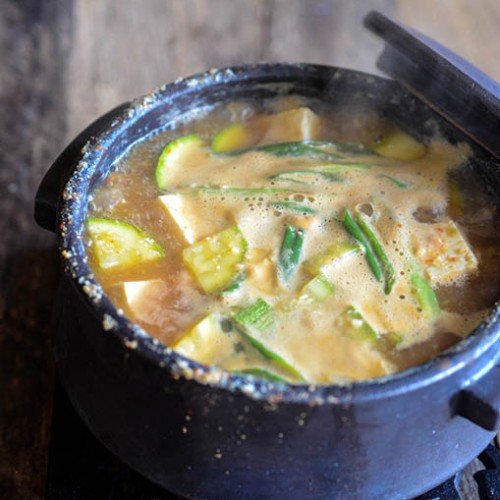
















Just want to say how much I love this recipe. I make it weekly! Just swap the beef for tvp and add some cooked thin rice noodles when ready to serve.
Thank you so much Lou! I never had it with noodles but sounds wonderful. Thank you for the 5 stars!!
I used gochujang and tofu instead of miso and beef because that’s what I had, but it’s still delicious! Just what I needed when I’m tired and it’s cold and rainy out.
Sure that sounds perfect for a cold and rainy day! Gochujang or Doenjang – both make delicious soups and stews. Thank you for your comment!